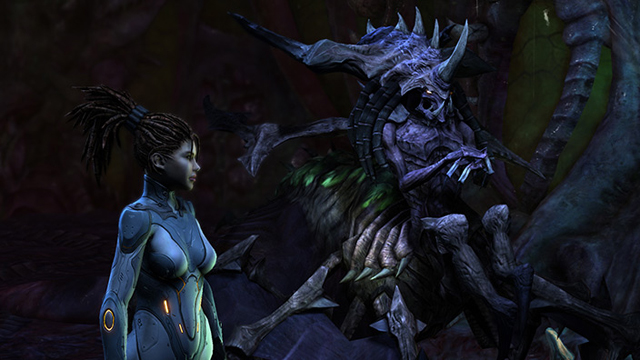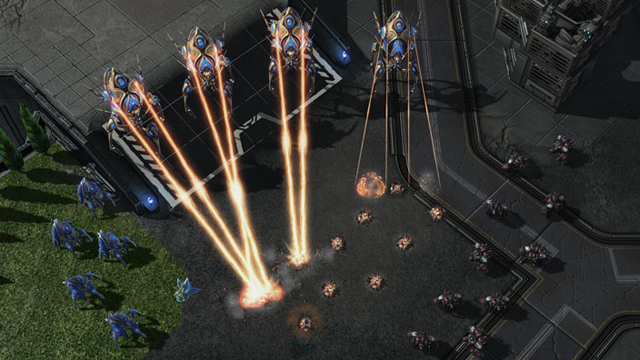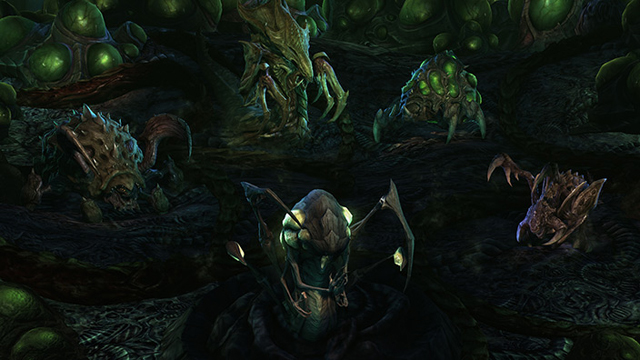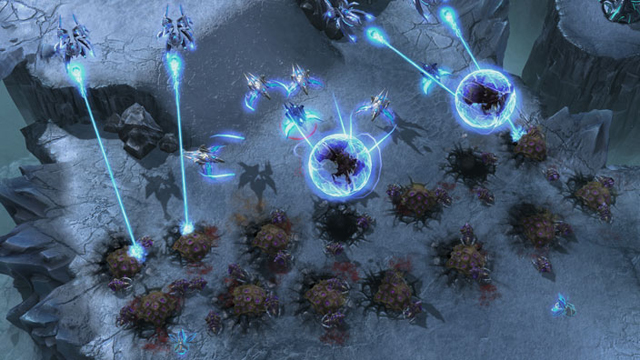 Game: StarCraft II: Heart of the Swarm
Game: StarCraft II: Heart of the Swarm
Developer: Blizzard Entertainment
Publisher: Activision Blizzard
Available on: PC Only
Imagine going up to Johnny Depp and saying, “You’ve got a mark on your cheek.” You wouldn’t do it, would you? If Johnny Depp has a mark on his cheek then it’s probably some artistic fashion statement, or a part of preparing for his next starring role. It’s certainly not a crumb from his hot cross bun. Reviewing StarCraft II: Heart of the Swarm feels a bit like this, only I’m forced into telling it about that crumb on its cheek. Then I have to offset that by saying that its hair looks nice today.
But StarCraft II: Heart of the Swarm doesn’t need to know about some iddy biddy crumb. StarCraft is huge. StarCraft is the confident chap that sits in public singing out loud. It know hows big it is so you either like what it’s singing or leave; it’s not changing the track. Heart of the Swarm is an expansion, a variation on the melody, that’s made for itself and for its fans, not some lowly crumb spotter that can’t discern the difference between Terran Mech and Terran Biomech.
But over confidence can lead to missteps, and even in its own bubble StarCraft is but one mistake away from a whole face of crumbs; and if that should happen no-one would neglect to mention it. So just how successful is Heart of the Swarm as an expansion, and does it ensure the StarCraft name remains one of largely crumb-free quality?
STORY: Sara Kerrigan is the star of Starcraft II: Heart of the Swarm’s Zerg focused tale. The ghost operative-turned-queen of the Zerg was taken down at the culmination of Starcraft II: Wings of Liberty, dethroned via ancient magic and reunited with long time flame Jim Raynor. Heart of the Swarm opens with Kerrigan proving she’s not entirely free of her Zerg powers, and quickly establishes the fact that global hick leader Arcturus Mengsk isn’t a fan of the fact she’s still walking and talking, albeit walking and talking with human comprehension and compassion.

Kerrigan’s tale quickly takes a nose dive, however, and she’s forced back into the claws, blades, teeth and hunger of the drooling Zerg. From here the narrative focuses on Kerrigan, her effort to re-establish the alien army that was scattered upon her forced abdication, and her general cursing revenge against Mengsk for being Mengsk.
Wings of Liberty managed to craft an interesting tale largely due to the human characters that populated your craft, and the plot points it ignited. While its mission designs remain interesting and varied, Heart of the Swarm is largely less successful from a narrative perspective. The tale it tells is important to StarCraft lore but is rather self-indulgent towards its leading lady.
It’s not that Kerrigan’s rise isn’t endearing, because it is. And the series’ trademark pulp sci-fi is still the guilty delight it’s always been, packed with more cheese and macho gusto than a Starship Troopers/Aliens double bill. The “issue” is that the Zerg aren’t really the sort you’d invite to afternoon tea. Imagine talking to a room of Daleks for a few hours and you’ll cover the majority of Heart of the Swarm’s cast. The constant talk of devouring and essence and broods and swarms can all be a bit one note when it’s magnified at this volume. You’ll relish seeing a human face, with the game’s final third being the best portion of the campaign for them.

GRAPHICS: If you’ve seen Wings of Liberty, you’ve seen Heart of the Swarm. The game does use several new tile-sets for its battlegrounds, such as verdant jungles, as well as a new physics based engine for death throws (of which there are many), but in terms of the artistry on display it’s all very familiar and not a huge leap over what StarCraft II was doing before now.
Of course that shouldn’t be taken as anything discrediting. Being able to see Zerg units in fully-realised, screen-filling glory during the campaign is a privilege, and the game is never visually bad. The only times Heart of the Swarm truly borders on looking a bit iffy are moments when Kerrigan is animated during campaign missions – the talking head and waddling miniature combo certainly lacks the impact of the game’s fully animated scenes and can come across as primitive.
During play, Heart of the Swarm’s best visual impact comes from being Zerg-centric; the game’s campaign joyously throws hundreds of the ant-like units around. While the miniatures may not hold up to scrutiny, seeing hundreds of them mashed together like an unattractive rugby scrum – well, like a rugby scrum – still has a unique and impressive charm.

SOUND: Sound is arguably the one area where the StarCraft series is a little wobbly on its feet. Dialogue is presented in an amusing manner, its tongue super glued inside its cheek, and you’ll only have complaints with that side of proceedings if you’re not on board with the series’ identity.
Music, on the other hand, is painfully piecemeal. Guitar-led synthesizers fall largely on the side of ambience, with music bearing none of the impact or energy of the gameplay or visuals that ride alongside it. Wings of Liberty managed to get by thanks to its lackadaisical southern twang but Heart of the Swarm’s sound is largely devoid of personality, busying itself somewhere on your periphery while the rest of the game amuses in spades.
GAMEPLAY: Mass base-building RTS games aren’t the craze they once were, and this only works to StarCraft’s benefit. Slipping into the game is a feeling of comfort, of old times and, nowadays, one of unique pleasure.
Ignoring situational alterations, the main focus of Starcraft II: Heart of the Swarm is the same as ever: build a base, populate it with workers, gather minerals and gas, use minerals and gas in the construction of other units and buildings, then build an army with which to assault and conquer your opponent’s minions before they do the same unto you. Different units have abilities and counters, and how you use your varied army to support and gel with one another can mean the difference between success and crushing defeat.

That said the single player campaign of Heart of the Swarm does an interesting job of messing with the recipe in order to make it as entertaining as possible. For starters, you have a hero unit on the field for most levels and using their powers to lead your army to victory is somewhat reminiscent of Warcraft III. Secondly, mid-mission interludes let you augment your units and then permanently ‘evolve’ them in a way to fit your play style. Thirdly, some levels are just surprising. From Diablo III-mimicking boss battles to space combat, Heart of the Swarm’s levels are welcome-ly unpredictable.
As a single player game Heart of the Swarm is excellent. Ignoring any personal issues with the rigid mid-mission chatter, Heart of the Swarm’s attention to keeping the player in control and ensuring that they feel like this is their game, and not just a medium for Kerrigan’s tale, is one of Heart of the Swarm’s biggest successes.
Deciding that I want Kerrigan to be able to spawn suicidal Banelings, and that I want those Banelings to be able to leap up ridges and towards enemies, gives a sense of personal pride when I put the unit into action. Throw in tricky achievements, crushing difficulty options and what amounts to a New Game+ mode and Heart of the Swarm presents a compelling game even if you’re only interested in the solo attractions.

Indeed, you could find enough gameplay enjoyment in AI skirmishes. You’ll find no hiccups with unit movement, or faulty logic in terms of conflict conclusions. StarCraft II is just a dang polished game and if you’re after a base-building, mass-army strategy game, Starcraft II Heart of the Swarm simply represents more of the best. The fact that its single player is so varied and well designed is a bonus.
MULTIPLAYER: Competitive StarCraft II is a phenomenon. To hypothesise the long term implications of Heart of the Swarm’s new elements is a guaranteed route to “Egg-on-my-Face Avenue”, so let’s just look at the obvious “what’s new” elements, and see how Heart of the Swarm attempts to create a more approachable multiplayer game for newcomers.
Heart of the Swarm adds seven new units to play. The Terran’s get the offensive defensive capabilities of the Widow Mine alongside the powerful Hellbat. The Zerg are gifted with an airborne tactician, the Viper, and a moveable unit factory, the Swarm Host. The final three units belong to the Protoss – the supportive Mothership Core, the aerial sniper Tempest unit, and the worker harasser and general nuisance that is the Oracle.
Seven may not sound like many but what these units present is choice. Each has an application or design that masks a weakness while revealing new strategies in each army. Take the Widow Mine, this hidden proximity bomb can be used as discrete defence inside a base, or to cover a mid-map push. Elsewhere, the Viper makes the Zerg air-game far less predictable, giving reactive players more opportunities for unpredictable play as they pull enemy units around the map and disable key defences. All of these new units are thoughtful additions to the carefully balanced scales of Starcraft II multiplayer and some, the Widow Mine in particular, are already being relied upon at a competitive level.

These new units are just an aside to a monsoon of balancing changes that have affected high-end play significantly. Anyone that found Zerg Brood Lords to be too powerful in Wings of Liberty may wish to hop back in, as their teeth have been harshly sanded down. In terms of balance and ease of play, Heart of the Swarm is a different and notably superior game to Wings of Liberty from the outset.
Playing Heart of the Swarm is easier as well. Well, learning to play Heart of the Swarm multiplayer is easier. Playing StarCraft multiplayer is still a lesson in humility served with a side of self-loathing and carpal tunnel concern (though that message is muted somewhat through a new levelling system with aesthetic rewards), but Heart of the Swarm makes more in-game efforts to teach you how to enjoy those things.
A tutorial sits on the multiplayer menu, designed expressly to “help players make the transition from single player to multiplayer”. Does it work? Well, it’s alright. It does a good job of introducing the theory, but it’s largely up to the player to mould something worthwhile from a rather unshapely lump of clay that’s babbling numbers and tips at them. What will help more is the introduction of player matches. Free from disheartening league-bracket branding (I know I’m bad, and seeing four leagues of “better” players above me does little to encourage), player matches are better for encouraging curious toe-dipping than their ranked brethren.

StarCraft II multiplayer is still a titanium wall of a challenge to get into unfortunately, even if Blizzard have tapped a few advice tabs on the front. If you put the effort in then you can understand it, but it’s still a cruel and gruelling process that certainly isn’t for everyone.
Undoubtedly the best addition, though admittedly one aimed squarely at those already neck-deep in StarCraft II, is the expanded replay feature suite. Players are able to watch a replay and, at any point, take active control of the rest of the match. You need a friend to sit in for the other player, but the ability to download a professional game and take control at the pivotal battle at minute 15, trying to emulate advanced skills, is a staggering step forward in terms of both learning and appreciating the game.
LONGEVITY: You’ll definitely get enough from Starcraft II: Heart of the Swarm, no matter your preference of play. The campaign isn’t short, pushing 15 to 20 hours of bug-swarming, world-devouring amusement, and in that time it twists and flexes the concept of what single player StarCraft can be further than Wings of Liberty managed.

Elsewhere, the multiplayer lasts as long as you do. The new units are worthy additions and the mix of levelling and tiered ranking systems ensure that you’ll always have a purpose to play, even if you’re a bit rubbish. Even if you just want to sit there playing fan-made games in the new, easy to browse StarCraft arcade, you’ll find hours of enjoyment here.
VERDICT: Heart of the Swarm doesn’t change the game, it expands it – which, admittedly, is the definition of an expansion. While the measure of changes present in its solo and multiplayer elements may differ, both sides do enough to ensure that Heart of the Swarm feels significant and worthy for anyone. The single player takes brave stabs at encouraging ballsy and powerful play, even if the narrative can be a little cumbersome, while multiplayer sees new, crucial cogs inserted to the machine with scientific precision.
StarCraft II: Heart of the Swarm is not an attempt to coerce newcomers to the fold. Those that don’t have a fondness for a Zerg rush every now and then won’t find anything here to convert them. What Heart of the Swarm does do is satisfy fans. Anyone that has ever enjoyed StarCraft will find fresh, appealing content in Heart of the Swarm, and those with a taste for its multiplayer will find an extra zing and tang that should ensure Blizzard’s timeless design stays fresh for another few hundred matches. A success then, and certainly not the game to point-out crumbs over.







